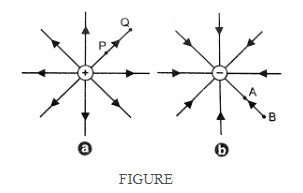Give the sign of the potentiaol energy difference of a small negative charge between the points Q and P,A and B.
A small negative charge will be attracted towards positive charge. The negative charge moves from higher petential energy to lower potential energy. Therefore the sign of potential energy difference of a small negative charge between Q and P is positive.
similarly (P.E.)A>(P.E.)B and hence sign of potential energy differences is positive.
Topper's Solved these Questions
- ELECTROSTATIC POTENTIAL AND CAPACITANCEBOOK - VIKRAM PUBLICATION ( ANDHRA PUBLICATION)CHAPTER - ELECTROSTATIC POTENTIAL AND CAPACITANCEEXERCISE - Important Questions
3 Videos
- ELECTROSTATIC POTENTIAL AND CAPACITANCEBOOK - VIKRAM PUBLICATION ( ANDHRA PUBLICATION)CHAPTER - ELECTROSTATIC POTENTIAL AND CAPACITANCEEXERCISE - SAQs
4 Videos
- ELECTROSTATIC POTENTIAL AND CAPACITANCEBOOK - VIKRAM PUBLICATION ( ANDHRA PUBLICATION)CHAPTER - ELECTROSTATIC POTENTIAL AND CAPACITANCEEXERCISE - Additional Excercise
36 Videos
- ELECTROMAGNETIC WAVEBOOK - VIKRAM PUBLICATION ( ANDHRA PUBLICATION)CHAPTER - ELECTROMAGNETIC WAVEEXERCISE - ADDITIONAL EXERCISES
19 Videos
- MAGNETISM AND MATTERBOOK - VIKRAM PUBLICATION ( ANDHRA PUBLICATION)CHAPTER - MAGNETISM AND MATTEREXERCISE - Additional Exercises
19 Videos
Similar Questions
Figures (a) and (b) show the field lines of a positive and negative point charge respectively.

(a) Give the signs of the potential difference VP−VQ,VB−VA.
(b) Give the sign of the potential energy difference of a small negative charge between the points Q and P, A and B.
(c) Give the sign of the work done by the field in moving a small positive charge from Q to P.
(d) Give the sign of the work done by the external agency in moving a small negative charge from B to A.
(e) Does the kinetic energy of a small negative charge increase or decrease in going from B to A?
View SolutionFigures (a) and (b) show the field lines of a positive and negative point charge respectively

(a) Give the signs of the potential difference VP−VQ,VB–VA.
(b) Give the sign of the potential energy difference of a small negative charge between the points Q and P, A and B.
(c) Give the sign of the work done by the field in moving a small positive charge from Q to P.
(d) Give the sign of the work done by the external agency in moving a small negative charge from B to A.
(e) Does the kinetic energy of a small negative charge increase or decrease in going from B to A?
View Solution
Knowledge Check
The potential difference between the points P and Q in the adjoining circuit will be-
 A(C1C4−C2C3)E(C1+C3)(C2+C4)BC2C3EC1C2(C3+C4)CC2C3−C1C4E(C1+C2)(C3+C4)D(C2C3−C1C4)E(C1+C2+C3+C4)
A(C1C4−C2C3)E(C1+C3)(C2+C4)BC2C3EC1C2(C3+C4)CC2C3−C1C4E(C1+C2)(C3+C4)D(C2C3−C1C4)E(C1+C2+C3+C4)
Figure (a) and (b) show the field lines of a positive and negative point charge respectively.

(a) Give the signs of the potential difference . Vp−VQ,VB−VA
(b) Give the sign of the potential energy difference if a small negative charge is moved from points Q to P from point A to B.
(c) Give the sign of the work done by the field in moving a small positive charge from Q to P.
( d) Give the sign of the work done by the external agency in moving a samall negative charge from B to A .
(e ) Does the kinetic energy of a small negative charge increase or decrease in going from B to A ?
View SolutionFig (a) and (b) show the field lines of a single positive and negative charges respectively .
Give the sign of the work done by an external agency in moving a small negative charge from B to A .

View SolutionFig (a) and (b) show the field lines of a single positive and negative charges respectively .
Does the kinetic energy of a small negative charge increase or decrease in going from B to A ?

View SolutionGive the sign of a rational number in which the numerator is negative and the denominator is negative.
View SolutionThe potential difference between the points P and Q in the adjoining circuit will be-

View SolutionTwo point charge q1=−10×10−6C and q2=15×10−6 are 40 cm apart as shown in figure. Find the potential difference between the point P and Q.

View SolutionGive the sign of a fraction in which the numerator is negative and the denominator is negative.
View Solution
